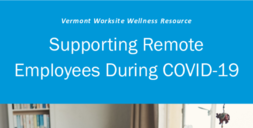For much of the week, most Vermonters spend more than a third of their day working. The programs, policies, and environment at their workplace significantly influence the overall health of employees and their families throughout the life course. Worksites can also have a positive impact on the communities in which they are located. With support and resources from the Health Department, worksites can take steps to improve employee health.
Get started addressing worksite wellness in your organization. The pages in this section provide strategies, templates, and other resources to help start or expand a worksite wellness initiative. You'll also find resources specific to certain occupations – farming, transportation, early childcare, food service, health care support, and buildings and grounds.




